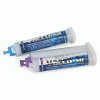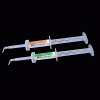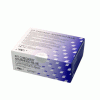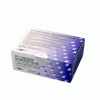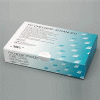You must be signed in to read the rest of this article.
Registration on CDEWorld is free. You may also login to CDEWorld with your DentalAegis.com account.
Yttria-stabilized tetragonal zirconia oxide (Y-TZP) ceramics, which are simply referred to as "zirconia," have become extremely popular for indirect dental restorations. Zirconia's popularity is due in large part to the fact that it combines high fracture strength and toughness with some degree of translucency.1 However, the use of zirconia in adhesive dentistry has presented challenges because of its lack of a glass phase, which makes hydrofluoric acid etching ineffective.2 Although full-coverage zirconia restorations can be effectively inserted using a conventional cementation protocol when the preparation provides adequate retention, using zirconia for partial-coverage restorations or resin-bonded fixed dental prostheses requires a reliable bonding protocol.2
Early Research
Studies dating back as far as 1995 have investigated the resin bond to high-strength ceramics.3-5 Although many bonding protocols for zirconia have been shown to work in the short term, the evidence indicates that pretreating zirconia's surface with air-particle abrasion and using an adhesive composite-resin luting agent that incorporates specialized adhesive phosphate monomers, especially 10-methacryloyloxydecyl dihydrogen phosphate (10-MDP), is necessary to achieve a strong and durable long-term bond.3-5 Interestingly, some of the adhesive resin cements that are appropriate for bonding zirconia were developed to bond metal-alloy restorations.
The author of this article and his colleagues began studying bonding to alumina and zirconia in the early 2000s, and their research has included thousands of specimens and most of the commonly available surface pretreatment and cement options.6-12 Although other studies only used polished ceramic samples, the author and his colleagues also investigated the intaglio surfaces of milled ceramic restorations and found that, when compared with adhesive composite resins containing 10-MDP, specific primers containing 10-MDP demonstrated the ability to better wet the slightly rough surfaces and provided superior long-term bond strengths to air-particle—abraded high-strength ceramics. Other methods of pretreating zirconia to improve bond strength have been examined, including the use of various acid etchants and plasma coating, and although some have shown promising results, the feasibility of their use in routine clinical practice is limited.
Latest Research
Since the author of this article and his colleagues published "How to Bond Zirconia: The APC Concept" in Compendium of Continuing Education in Dentistry in 2016,13 further research has confirmed the efficacy of zirconia bonding. A clinical study of zirconia cantilever resin-bonded fixed dental prostheses published in 2017 by Kern and colleagues reported a 10-year survival rate of 98.2% and a success rate of 92.0%.14 In a 2018 case report by Souza and colleagues, the authors reported satisfactory results after a 1-year follow-up on ultrathin monolithic zirconia veneers that had been adhesively luted to enamel surfaces on minimally invasive preparations after airborne-particle abrasion and application of a 10-MDP primer.15 And in a 2023 systematic review and meta-analysis by Al-Bermani and colleagues, the researchers concluded that the evidence supporting the use of single-retainer zirconia resin-bonded fixed dental prostheses as a suitable treatment option for the replacement of anterior missing teeth was considerable. Based on the findings, they recommended a protocol that included airborne-particle abrasion and resin-zirconia adhesion with 10-MDP.16
As newer zirconia formulations have been developed, ongoing research has shown that the efficacy of the bonding protocol involving airborne-particle abrasion and adhesion with 10-MDP remains unchanged. In a 2022 systematic review by Alammar and Blatz, the available evidence suggested that the resin bonding protocols that had been successfully applied to conventional zirconia were also the most successful for high-translucent zirconia. The study not only concluded that durable bonds could be established with high-translucent zirconia but also found that the bonding materials and procedures applied did not compromise its physical properties.17
In other research validating the use of airborne-particle abrasion and 10-MDP, Alammar and Att conducted a 2021 systematic review of in vitro studies focusing on the durability of different bonding protocols applied to zirconia restorations with different types of tooth or implant abutments and concluded that surface pretreatment with airborne-particle abrasion had a positive influence on the resin bonding of zirconia to most of the types of tooth and implant abutments identified.18 Alammar and Att also concluded that chemically activating the treated zirconia surfaces with a 10-MDP monomer-based primer, along with using a 10-MDP monomer or phosphate ester monomer-based resin cement, was a durable bonding protocol, although the type of resin cement used seemed to be a less influential factor.18
Some clinicians assert that airborne-particle abrasion weakens zirconia. Contrary to this common belief, a study published in 2018 by Ozer and colleagues found that airborne-particle abrasion performed within clinically relevant parameters did not weaken monolithic zirconia—it actually increased its flexural strength.19 Research published in 2019 by Aung and colleagues determined that an alumina-blasting pressure of 0.2 MPa was the most effective for reliable and durable bonding performance to translucent zirconia.20 Regarding the timing of airborne-particle abrasion, a study published in 2021 by Al-Akhali and colleagues found that the time between the airborne-particle abrasion of zirconia and the application of the adhesive materials should be minimized when bonding nonretentive zirconia restorations. Ideally, a primer containing 10-MDP should be immediately applied after airborne-particle abrasion and without additional cleaning.21 This is extremely important because it demonstrates that the primary benefit of airborne-particle abrasion during the zirconia bonding process is decontamination rather than roughening. When contamination occurs after air abrasion, such as during try-in, it is best to air abrade again. If no unit is available, the use of a cleaning agent can work, but it is less effective.22
Research into the efficacy of zirconia bonding protocols has found that the use of 10-MDP not only improves bond strength but also does so long term. In a study published in 2018 by Yagawa and colleagues, the researchers found that the application of priming agents containing 10-MDP enhanced the bond strengths of resin-based luting agents to a translucent zirconia material.23 Later that same year, Yang and colleagues reported that 10-MDP-containing primers, universal adhesives, and composite cements create bonds to zirconia that demonstrate acceptable strength after long-term aging.24 Research published by Garcia and colleagues in 2022 that evaluated the effect of different luting techniques on the shear bond strength of ultra-translucent multi-layered zirconia concluded that clinicians should prefer 10-MDP—based cementation systems that can be properly polymerized to achieve long-term bond strength to yttria-stabilized zirconia restorations.25
The APC Protocol
The APC zirconia-bonding concept, which was originally published in Compendium of Continuing Education in Dentistry,13 is based on two decades of research on this topic by the author.13 The success of resin bonding relies on proper material selection and adequate treatment of the bonding surfaces of the abutment tooth and the restoration.6 The abutment tooth should be treated with a bonding agent as recommended by the manufacturer. Only dentin bonding agents that are specifically indicated for indirect restorations should be selected for this purpose because many self-etch adhesives are limited to direct restorations due to their increased film thickness and need for photopolymerization.26
To practically achieve the high and long-term durable resin bond strengths to zirconia, the APC zirconia bonding concept utilizes a three-step approach: (A)irborne-particle abrasion of the bonding surface of the restoration with aluminum oxide, application of a 10-MDP containing (P)rimer to the air-abraded surface, and the use of a dual-cure or self-cure (C)omposite resin cement to place the restoration.
APC Protocol Step A
After a zirconia restoration is tried-in and cleaned, the intaglio surface should be airborne-particle abraded with alumina or silica-coated alumina particles (Figure 1). Some clinicians refer to this procedure as sandblasting or microetching. To air-abrade zirconia, a chairside microetcher using small particles ranging from 50 µm to 60 µm at a low pressure (ie, below 2 bar) is sufficient.7,9,11,12,27 The overall effect of pretreatment with alumina seems to be more important than the actual degree of surface roughening that it achieves, especially because of its ability to effectively decontaminate the bonding surfaces.27 As previously mentioned, the effects of air-particle abrasion on the flexural strength of zirconia have been discussed extensively, and most existing studies indicate that the use of particularly small particles actually provides a strengthening effect.28
APC Protocol Step P
The next step in the APC protocol involves applying a zirconia primer that contains specialized adhesive phosphate monomers, including 10-MDP, to the surfaces of the zirconia that will be bonded (Figure 2).29,30 The monomer 10-MDP, which is also used in some dentin bonding agents and cements, has been shown to be particularly effective in bonding metal-oxide ceramics such as zirconia. Although zirconia primers may also increase the abilities of other cements, such as resin-modified glass ionomers, to bond to zirconia,31 it is highly recommended that clinicians only use such primers with the bonding agents and other products within their product lines and not try to mix and match products from different manufacturers. These products may have similar names, but they likely have different chemical compositions that may not be compatible with each other. Some clinicians may be confused by the fact that some zirconia and ceramic primers with specialized adhesive phosphate monomers also contain silanes, which make them universally applicable to various materials, including silica-based ceramics. But remember, silanes contribute no effect to the long-term strength of bonds to metal-oxide—based ceramics unless they are coated with a silica-based ceramic or silica-containing particles.12
APC Protocol Step C
The final step in the APC protocol is to place the pretreated restoration using a dual- or self-cure composite resin (Figure 3 through Figure 5). A dual- or self-cure material should be used to ensure adequate polymerization/conversion beneath zirconia restorations because they reduce light transmission.6 However, high-translucent zirconia restorations transmit enough light that the shade of the cement or composite-resin luting agent used to place them influences their final appearance. It is, therefore, highly recommended to verify the anticipated appearance of such restorations with try-in pastes and select the most adequate cement shade based on the individual situation and the shade of the abutment tooth.
Conclusion
Use of the APC zirconia-bonding concept is mandatory for zirconia restorations such as resin-bonded fixed dental prostheses,32 laminate veneers, and inlays/onlays,33,34 all of which can demonstrate excellent longevity if they are bonded correctly.32 In addition, it is not limited to teeth and is also applied in the laboratory, such as for implant reconstructions that include cemented zirconia components. For new high-translucent zirconia products with lower flexural strength, proper bonding is even more important and may be necessary for restorations fabricated at minimum thicknesses because resin bonding increases ceramic strength. Using the APC zirconia-bonding concept is not necessary for full-coverage restorations with adequate retention, which can be inserted using a conventional cementation protocol.
Research continues to confirm the efficacy of zirconia bonding protocols that include pretreatment of the zirconia surfaces with airborne-particle abrasion and a zirconia primer followed by placement with a dual- or self-cure composite resin. As such, zirconia should be considered a viable material for partial-coverage restorations and resin-bonded fixed dental prostheses when a proper protocol is followed.
Queries regarding this course may be submitted to authorqueries@broadcastmed.com
About the Author
Markus B. Blatz, DMD, PhD
Chair and Professor of Restorative Dentistry
Department of Preventive and Restorative Sciences
Assistant Dean
Digital Innovation and Professional Development
University of Pennsylvania
School of Dental Medicine
Philadelphia, Pennsylvania
References
1. Blatz MB, Conejo J. The current state of chairside digital dentistry and materials. Dent Clin North Am. 2019;63(2):175-197.
2. Blatz MB, Alammar A, Ayub JM, et al. How to bond to current CAD/CAM ceramics. Compend Contin Educ Dent. 2023;44(10):560-565.
3. Kern M, Thompson VP. Bonding to glass infiltrated alumina ceramic: adhesive methods and their durability. J Prosthet Dent. 1995;73(3):240-249.
4. Kern M, Wegner SM. Bonding to zirconia ceramic: adhesion methods and their durability. Dent Mater. 1998;14(1):64-71.
5. Wegner SM, Kern M. Long-term resin bond strength to zirconia ceramic. J Adhes Dent. 2000;2(2):139-147.
6. Blatz MB, Sadan A, Kern M. Resin-ceramic bonding: a review of the literature. J Prosthet Dent. 2003;89(3):268-274.
7. Blatz MB, Oppes S, Chiche G, et al. Influence of cementation technique on fracture strength and leakage of alumina all-ceramic crowns after cyclic loading. Quintessence Int. 2008;39(1):23-32.
8. Blatz MB, Bergler M. Clinical application of a new self-adhesive resin cement for zirconium-oxide ceramic crowns. Compend Contin Educ Dent. 2012;33(10):776-781.
9. Blatz MB, Phark JH, Ozer F, et al. In vitro comparative bond strength of contemporary self- adhesive resin cements to zirconium oxide ceramic with and without air-particle abrasion. Clin Oral Investig. 2010;14(2):187-192.
10. Blatz MB, Sadan A, Arch GH Jr, Lang BR. In vitro evaluation of long-term bonding of Procera AllCeram alumina restorations with a modified resin luting agent. J Prosthet Dent. 2003;89(4):381-387.
11. Blatz MB, Sadan A, Martin J, Lang B. In vitro evaluation of shear bond strengths of resin to densely-sintered high-purity zirconium-oxide ceramic after long-term storage and thermal cycling. J Prosthet Dent. 2004;91(4):356-362.
12. Blatz MB, Chiche G, Holst S, Sadan A. Influence of surface treatment and simulated aging on bond strengths of luting agents to zirconia. Quintessence Int. 2007;38(9):745-753.
13. Blatz MB, Alvarez M, Sawyer K, Brindis M. How to bond zirconia: the APC concept. Compend Contin Educ Dent. 2016;37(9):611-617.
14. Kern M, Passia N, Sasse M, Yazigi C. Ten-year outcome of zirconia ceramic cantilever resin-bonded fixed dental prostheses and the influence of the reasons for missing incisors. J Dent. 2017;65:51-55.
15. Souza R, Barbosa F, Araújo G, et al. Ultrathin monolithic zirconia veneers: reality or future? Report of a clinical case and one-year follow-up. Oper Dent. 2018;43(1):3-11.
16. Al-Bermani ASA, Quigley NP, Ha WN. Do zirconia single-retainer resin-bonded fixed dental prostheses present a viable treatment option for the replacement of missing anterior teeth? A systematic review and meta-analysis. J Prosthet Dent. 2023;130(4):533-542.
17. Alammar A, Blatz MB. The resin bond to high-translucent zirconia-A systematic review. J Esthet Restor Dent. 2022;34(1):117-135.
18. Alammar A, Att W. Bonding durability between zirconia and different types of tooth or implant abutments-a systematic review. Part I: outcomes of in vitro studies. Int J Prosthodont. 2021;34(5):650-669.
19. Ozer F, Naden A, Turp V, et al. Effect of thickness and surface modifications on flexural strength of monolithic zirconia. J Prosthet Dent. 2018;119(6):987-993.
20. Aung SSMP, Takagaki T, Lyann SK, et al. Effects of alumina-blasting pressure on the bonding to super/ultra-translucent zirconia. Dent Mater. 2019;35(5):730-739.
21. Al-Akhali M, Al-Dobaei E, Wille S, et al. Influence of elapsed time between airborne-particle abrasion and bonding to zirconia bond strength. Dent Mater. 2021;37(3):516-522.
22. Silva NRD, Araújo GM, Vila-Nova TEL, et al. Which zirconia surface-cleaning strategy improves adhesion of resin composite cement after saliva contamination? A systematic review and meta-Analysis. J Adhes Dent. 2022 13;24(1):175-186.
23. Yagawa S, Komine F, Fushiki R, et al. Effect of priming agents on shear bond strengths of resin-based luting agents to a translucent zirconia material. J Prosthodont Res. 2018;62(2):204-209.
24. Yang L, Chen B, Xie H, et al. Durability of resin bonding to zirconia using products containing 10-methacryloyloxydecyl dihydrogen phosphate. J Adhes Dent. 2018;20(4):279-287.
25. Garcia IM, Soto-Montero J, Collares FM, Giannini M. Bonding of resin cements to ultra-translucent zirconia after aging for 24 hours and 1 year. Int J Prosthodont. 2022;35(4):460-468.
26. Ozer F, Blatz MB. Self-etch and etch-and-rinse adhesive systems in clinical dentistry. Compend Contin Educ Dent. 2013;24(1):12-20.
27. Quaas AC, Yang B, Kern M. Panavia F 2.0 bonding to contaminated zirconia ceramic after different cleaning procedures. Dent Mater. 2007;23(4):506-512.
28. Song JY, Park SW, Lee K, et al. Fracture strength and microstructure of Y-TZP zirconia after different surface treatments. J Prosthet Dent. 2013;110(4):274-280.
29. Koizumi H, Nakayama D, Komine F, et al. Bonding of resin-based luting cements to zirconia with and without the use of ceramic priming agents. J Adhes Dent. 2012;14(4):385-392.
30. Nakayama D, Koizumi H, Komine F, et al. Adhesive bonding of zirconia with single-liquid acidic primers and a tri-n-butylborane initiated acrylic resin. J Adhes Dent. 2010;12(4):305-310.
31. Alnassar T, Ozer F, Chiche G, Blatz MB. Effect of different ceramic primers on shear bond strength of resin-modified glass ionomer cement
to zirconia. J Adhes Sci Technol. 2016; Doi. 10.1080/01694243.2016.1184404.
32. Maggio M, Bergler M, Kerrigan D, Blatz MB. Treatment of maxillary lateral incisor agenesis with zirconia-based all-ceramic resin bonded fixed partial dentures: a case report. Amer J Esthet Dent. 2012;2(4):226-237.
33. Blatz MB. Long-term clinical success of all-ceramic posterior restorations. Quintessence Int. 2002;33(6):415-426.
34. Mante FK, Ozer F, Walter R, et al. The current state of adhesive dentistry: a guide for clinical practice. Compend Contin Educ Dent. 2013;34:Spec 9:2-8.
